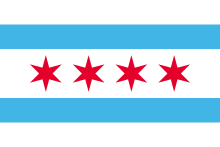Chicago flag
The flag of Chicago consists of two light blue horizontal stripes on a white field. Each stripe occupies exactly one sixth of the total height of the flag and is placed just under one sixth from the top or bottom edge. Four red six-pointed stars are arranged in a horizontal row between the two blue stripes.
In a 2004 Internet poll by the North American Vexillological Association , the flag of Chicago was voted the second best of all US city flags after the flag of Washington DC . Those who voted preferred simple but unmistakably designed flags over flags with more complex designs, for example with lettering or the city seal.
symbolism
Stripes
The white stripes of the flag represent, from top to bottom, the north, west and south sides of the city. The top blue stripe represents Lake Michigan and the northern arm of the Chicago River . The lower blue stripe represents the southern arm of the Chicago River and the Great Canal .
Stars
The four red six-pointed stars in the central white stripe, from left to right (although this is not the order in which they were added to the flag):
- The first star represents Fort Dearborn . It was added to the flag as the last star in 1939 and preceded the others. Its six rays symbolize transportation, work, trade, money, dense settlement and health.
- The second star represents the Great Chicago Fire of 1871 and was on the original flag from 1917. Its six rays symbolize the virtues of religion, education, aesthetics, justice, charity, and civic pride.
- The third star symbolizes the World's Columbian Exposition from 1893 and was also on the original flag from 1917. Its six rays represent the political entities to which Chicago has already belonged and whose flags have already flown in Chicago: France 1693, Great Britain 1763 , Virginia 1778, the Northwest Territories 1798, Indiana Territories 1802, and Illinois 1818.
- The fourth star represents the Century of Progress Exposition (1933–1934) and was added in 1933. Its rays represent bragging rights: the third largest city in the United States, Chicago's Latin motto ( Urbs in horto - city in a garden), Chicago's “I Will” motto, the Great Central Marketplace , Wonder City and Convention City .
A possible fifth star has already been proposed several times.
history
In 1915, Mayor William Hale Thompson appointed a flag commission that included the Impressionist painter Lawton S. Parker . Parker asked lecturer and poet Wallace Rice to develop rules for a public competition for the best flag design. In the end, the commission chose Wallace Rice's own draft. On April 4, 1917, its recommendation was approved by the city council.
In 1933 under Mayor Edward Joseph Kelly , a third star was added to the flag in honor of the current World's Fair . Finally, in 1939, a fourth star was added to commemorate the Fort Dearborn massacre . In the summer of 2007, the proposal came up to add a fifth star if the city had been awarded the capacity to host the 2016 Summer Olympics .
Individual evidence
- ↑ "Washington, DC Tops American City Flags Survey" ( Memento of the original from August 23, 2011 on WebCite ) Info: The archive link was automatically inserted and not yet checked. Please check the original and archive link according to the instructions and then remove this notice. North American Vexillological Association press release October 2, 2004
- ↑ " Chicago Flag May Get New Star if Olympics Come ( Memento of the original from September 30, 2007 in the Internet Archive ) Info: The archive link was inserted automatically and has not yet been checked. Please check the original and archive link according to the instructions and then remove this notice. ", CBS 2 , June 22, 2007.
